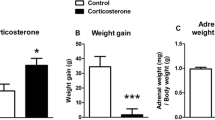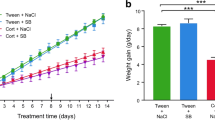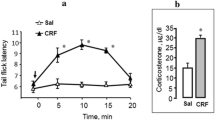Summary
To examine the influence of adrenal secretions on neuroleptic induced catalepsy, we studied the effect of adrenocorticoids, noradrenaline (NA) or adrenaline (AD) on haloperidol (HAL) induced catalepsy in adrenalectomised (ADX) and sham-adrenalectomised (sham-ADX) rats. HAL (1 mg/kg, i.p.) induced a greater degree of catalepsy in ADX rats as compared to sham-ADX rats. Corticosterone (CORT, 1–2 mg/kg, s.c.) or dexamethasone (1–2 mg/kg, s.c.) attenuated the HAL catalepsy in sham-ADX but not in ADX rats. Further, when the HAL (1 mg/kg) catalepsy score was maximal (at 120 min), the rats were subjected to cold stress (3 °C for 10 min) or treated with NA, AD (2 μg/kg, i.v.) or CORT (2 mg/kg, s.c.). After cold stress procedure or CORT treatment, the catalepsy was significantly reduced in sham-ADX but not in ADX rats, whereas NA or AD infusion caused an immediate but short lasting significant decrease in HAL catalepsy in both sham-ADX and ADX rats. The anticataleptic effect of NA or glucocorticoids was blocked by an α1adrenoceptor blocker, prazosin.
These findings suggest that peripheral noradrenergic and adrenergic mechanisms play an important role in the neuroleptic induced catalepsy. Such mechanisms may mediate the anticataleptic action of glucocorticoids.
Similar content being viewed by others
References
Antelman SM, Kocan D, Knopf S, Edwards DJ. Caggiula AR (1992) One brief exposure to a psychological stressor induces long lasting, time-dependent sensitization of both cataleptic and neurochemical responses to haloperidol. Life Sci 51: 261–266
Burns RS, Lewitt P, Ebert MH, Pakkenberg H, Kopin IJ (1985) The clinical syndrome of striatal dopamine deficiency. Parkinsonism induced by MPTP. N Engl J Med 312: 1418–1421
Den Hartog Jager WA (1970) Histochemistry of adrenal bodies in Parkinson's disease. Arch Neurol 23: 528–533
Grant DB, Dunger DB, Smith I, Hyland K (1992) Familial glucocorticoid deficiency with achalasia of the cardia associated with mixed neuropathy, long-tract degeneration with mild dementia. Eur J Pediat 151: 85–89
Hornykiewicz O (1966) Dopamine (3-hydroxytyramine) and brain function. Pharmacol Rev 18: 925–964
Jarkowski J (1925) Kinesie paradoxale des parkinsoniens. Masson, Paris
Jenner P, Sheehy M, Marsden CD (1983) Noradrenaline and 5-hydroxytryptamine modulation of brain dopamine function: implications for the treatment of Parkinson's disease. Br J Clin Pharmacol 15: 277S-289S
Kulkarni SK, Arzi A, Kaul PN (1980) Modification of drug induced catatonia and tremors by quipazine in rats and mice. Jpn J Pharmacol 30: 129–135
Lachuer J, Gaillet S, Barbagli B, Buda M, Tappaz M (1991) Differential early time course activation of the brain stem catecholaminergic groups in response to various stresses. Neuroendocrinology 53: 589–596
Nagao T, Tagaki K, Hashida H, Masaki T, Sakuta M (1991) A case of progressive systemic sclerosis and sjogren's syndrome complicated by parkinsonism with special reference to the beneficial effect of corticosteroids. Rinsno-Shinkeigaku 31: 1238–1240
Narabayashi H (1984) Akinesia in parkinsonism-clinical and pharmacological analysis of parkinsonian symptoms. Bull Acad Med Bel 139: 309–320
Pycock C (1977) Noradrenergic involvement in dopamine-dependent stereotyped and cataleptic responses in the rat. Naunyn Schmiedebergs Arch Pharmacol 298: 15–22
Riederer P, Rausch WD, Birkmayer W, Jellinger K, Seemann D (1978) CNS modulation of adrenal tyrosine hydroxylase in Parkinson's disease and metabolic encephalopathies. J Neural Transm [Suppl] 14: 121–131
Rubin RP (1990) Adrenocortical hormones and drugs affecting the adrenal cortex. In: Craig CR, Stitzel RE (eds) Modern pharmacology 3. Little Brown and Co, New York, pp 856–872
Siegel S (1956) Nonparametric statistics for the behavioral sciences. McGraw-Hill Kogakusha, Tokyo
Verhagen-Kamerbeek WDJ, Hazemeijer I, Korf J, Lakke JPWF (1993) Attenuation of haloperidol-induced catalepsy by noradrenaline and L-threo-DOPS. J Neural Transm [P-D Sect] 6: 17–26
Vetrugno GC, Lachuer J, Perego C, Miranda E, DeSimoni MG, Tappaz M (1993) Lack of glucocorticoids sustains the stress-induced release of noradrenaline in the anterior hypothalamus. Neuroendocrinology 57: 835–842
Yntema OP, Korf J (1987) Transient suppression by stress of haloperidol-induced catalepsy by the activation of the adrenal medulla. Psychopharmacology 91: 131–134
Author information
Authors and Affiliations
Rights and permissions
About this article
Cite this article
Chopde, C.T., Hote, M.S., Mandhane, S.N. et al. Glucocorticoids attenuate haloperidol-induced catalepsy through adrenal catecholamines. J. Neural Transmission 102, 47–54 (1995). https://doi.org/10.1007/BF01276564
Received:
Accepted:
Issue Date:
DOI: https://doi.org/10.1007/BF01276564




